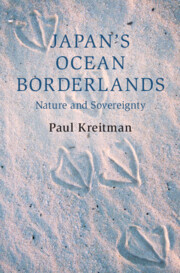Book contents
- Japan’s Ocean Borderlands
- Cambridge Oceanic Histories
- Japan’s Ocean Borderlands
- Copyright page
- Contents
- Maps
- Figures
- Acknowledgements
- Naming Conventions
- Maps
- Introduction
- 1 Bonins of Contention
- 2 The Race to Marcus Island
- 3 Bird and Sovereignty Conservation in the Northwest Hawaiian Islands, 1898–1911
- 4 Sand Dunes and Soldiers
- 5 Disaster
- 6 Resurrecting the Torishima Albatross
- 7 The Nature of the Senkaku Islands
- Epilogue
- Appendix Japanese Islands Abandoned, 1868–2013
- Select Bibliography
- Index
5 - Disaster
The Abandonment of Japan’s Remote Islands, 1902–1945
Published online by Cambridge University Press: 06 July 2023
- Japan’s Ocean Borderlands
- Cambridge Oceanic Histories
- Japan’s Ocean Borderlands
- Copyright page
- Contents
- Maps
- Figures
- Acknowledgements
- Naming Conventions
- Maps
- Introduction
- 1 Bonins of Contention
- 2 The Race to Marcus Island
- 3 Bird and Sovereignty Conservation in the Northwest Hawaiian Islands, 1898–1911
- 4 Sand Dunes and Soldiers
- 5 Disaster
- 6 Resurrecting the Torishima Albatross
- 7 The Nature of the Senkaku Islands
- Epilogue
- Appendix Japanese Islands Abandoned, 1868–2013
- Select Bibliography
- Index
Summary
Even before the war there were signs that many remote island settlements were struggling, but the outbreak of the Pacific War heaped death and devastation upon those few remote island communities that remained. By the end of 1942 it had become clear that the conflict would be fought on an island-by-island basis across the Pacific, as US forces scrabbled to gain a purchase on any scrap of land from which they might launch aerial bombing raids on the Japanese mainland. Many islands were transformed into military garrisons and one, Iwo Jima, became the site one of the most brutal battles of the war. After 1945, Japan was stripped of the vast majority of its island possessions, with Okinawa, the Bonins and Micronesia placed under indefinite US occupation. Those islands that remained under Japanese rule were transformed from stepping stones of colonial expansion to sites of anxiety about territorial loss, demographic decline and the vanishing of tradition. It was within this context that new ways of thinking about deserted islands began to emerge – not only as sites for economic development but also for the conservation of valuable but threatened nature.
Keywords
- Type
- Chapter
- Information
- Japan's Ocean BorderlandsNature and Sovereignty, pp. 152 - 166Publisher: Cambridge University PressPrint publication year: 2023

